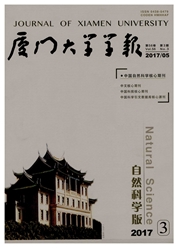

 中文摘要:
中文摘要:
利用第二代测序技术测定海洋生物转录组已成为揭示海洋生物分子生物学机制的重要工具.以长度为10nt的不同多重标签(multiplex identifier)进行区分,构建了杂色鲍(Haliotis diversicolor)、僧帽牡蛎(Saccostrea cucullata)和亚心形扁藻(Platymonass subcordiformis)3种海洋生物的12个多重标签转录组文库.以合适的比例对各文库进行混合,利用定量PCR、Qubit和NanoDrop-1000等3种DNA浓度测定方法测定每个多重标签转录组文库的DNA浓度,3种方法的数值均一化并加权平均后,按照预定比例混合.为评估文库质量,先采用传统的Sanger测序测定了混合文库的192条序列,发现191条序列具有符合Roche/454高通量测序要求的AB格式,即一端为454A序列,另一端为454B序列;其中189条序列能分辨出其带有的多重标签;插入的平均长度为348bp.然后通过Roche/454的滴定测序获得了34642条序列,其中32872条序列(94.9%)能分辨出其带有的多重标签,能够精确地分配到12个转录组,并且利用滴定测序结果计算出每个转录组文库的真实比例,对定量PCR、Qubit和NanoDrop-1000进行了评估,结果表明定量PCR是相对准确的定量方法.以上的评估表明所建立的转录组文库构建方法是稳定可靠的,可以广泛应用于转录组学研究.
 英文摘要:
英文摘要:
Next generation sequencing technologies have become an important tool to promote research on molecular biologic mecha nism of marine organisms. In this study, 12 transcriptomice libraries,each labeled by a specific multiplex identifier (MID) of 10 nu-cleotide, were constructed from three marine species:small abalone Haliotis diversicolor, Sengmao oyster Saccostrea cucullata and unicell green algae Platymonas subcordiformis. To make an appropriate mixture ratio,DNA concentration of each library was deter-mined by qPCR,Qubit and NanoDrop-1000 methods. The normalized and weighted average concentration numbers were used to pool libraries to a setting ratio. To evaluate the quality of the libraries,traditional Sanger sequencing was performed to sequence 192 cDNA fragments. Among them,191 fragments had the required AB format on Roche/454 platform,e, g. ,454A sequence was located on one end of the cDNA fragment and 454B sequence was located on the other end. And MID barcodes could be identified from 189 eDNA fragments. The average length of the cDNA fragments was 348 bp. To further evaluate the libraries, a titrimetric sequencing was performed on a Roche/454 GSFLX-Titanium platform and 34 642 sequences were generated. MID barcodes could be identified from 32 872 sequences (94.9%) and each of them could be precisely assigned to one of the 12 cDNA libraries. The real proportions of each MID calculated from titrimetric sequences were used to evaluate the three DNA concentration determined methods, playing an impor-tant role in library pooling. Results showed that the qPCR method could be the most credible one. As a conclusion, the transcriptom-ice library construction procedure described here was very stable and reliable, and it could be widely applied on transcriptomics re search.
 同期刊论文项目
同期刊论文项目
 同项目期刊论文
同项目期刊论文
 期刊信息
期刊信息
